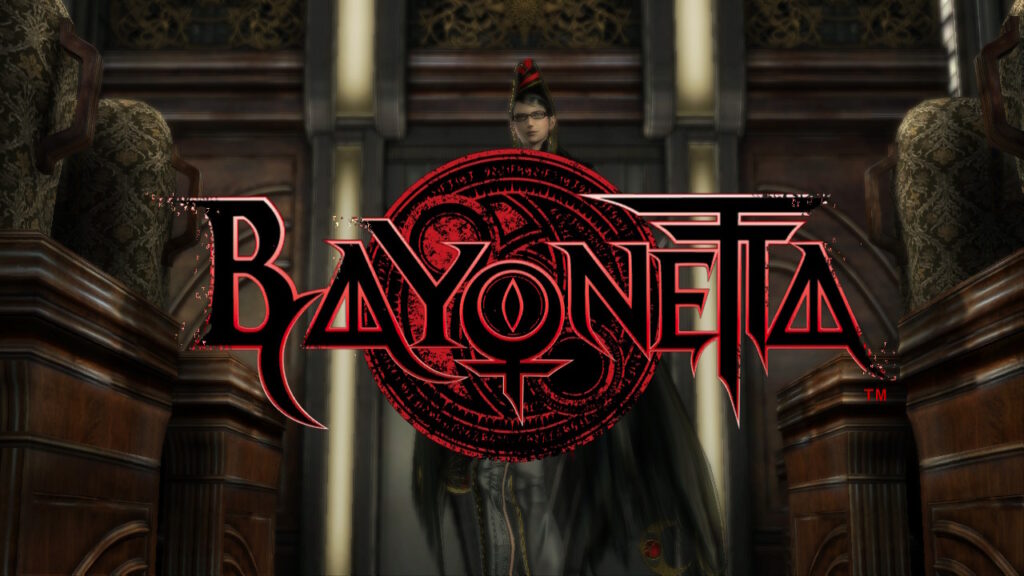
Hideki Kamiya revolutionized 3D action games with his original Devil May Cry. What began as a botched Resident Evil 4 prototype, became the bases for an entire sub-genre of action games. Although Devil May Cry still had the ethos of a survival-horror in its DNA, it was the style and set-pieces that drew a crowd like moths to a flame.
Kamiya would go on to refine action game mechanics for his entire career, eventually culminating with Bayonetta being his first HD title in the seventh console gen. Bayonetta proved to be a classic of its era, and cementing the titular protagonist as an icon of 3D stylish-action games.
Bayonetta would see many ports over the years, with the Nintendo Switch conversion and the 10th Anniversary Edition for PlayStation 4 and Xbox One being the best ways to play it. As times change, so do standards and tastes. Was Bayonetta a product of its day? Or has the umbran witch brawler withstood the ravages of time?
Bayonetta
Developer: PlatinumGames
Publisher: SEGA, Nintendo
Platforms: Windows PC, PlayStation 3, PlayStation 4, Xbox 360, Xbox One, Wii U, Nintendo Switch (reviewed)
Release Date: January 5, 2009 (PlayStation 3, Xbox 360), October 24, 2014 (Wii U), April 11, 2017 (Windows PC), February 16, 2018 (Nintendo Switch), February 18, 2018 (PlayStation 4, Xbox One)
Players: 1
Price: $29.99 (eShop), $19.99 (Xbox 360 XBLA), $24.99 (PSN/ XBLA)
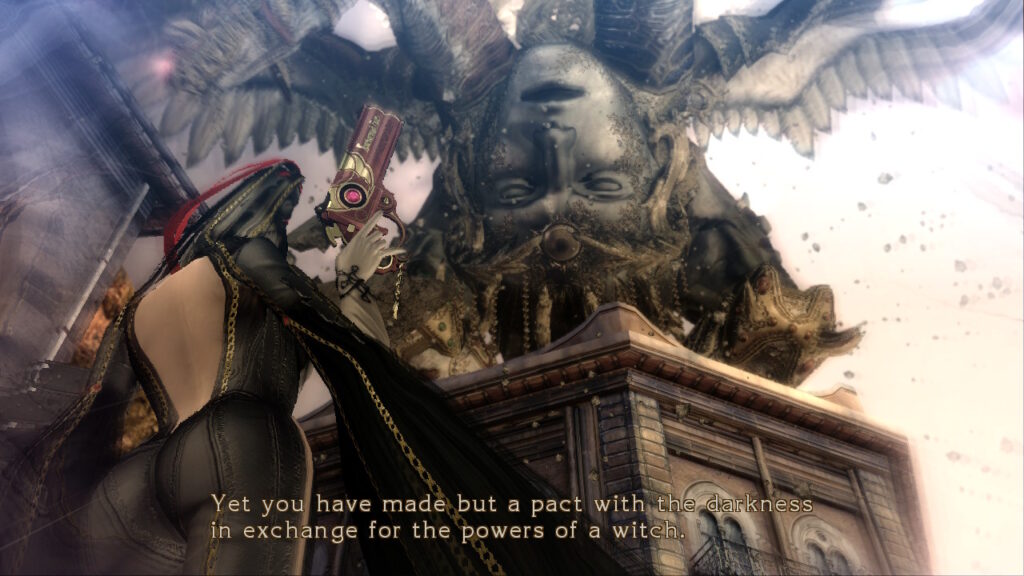
Just by how Bayonetta begins, you know you are in for something special. The opening cinematic begins with the striking visual of a falling clock tower, with two heroes fighting a horde of avian monstrosities. Frantic cellos drum up and a chorus swells; suddenly the game sets you loose and you are left to fend for yourself without warning or context.
All you know you must do, is fight. Enormous divine entities fill the screen without warning, and you are expected to come to grips with the controls to survive this encounter. Thankfully all of this is purely for show, but it does a great job at establishing the style and tone that is to come.
Bayonetta is a game that respects its players. It sets a bar high and gives you the means to experiment to clear it while never holding your hand. It is dense with minutia and intricacies in its combat systems, making it one of the most expressive action games ever made.
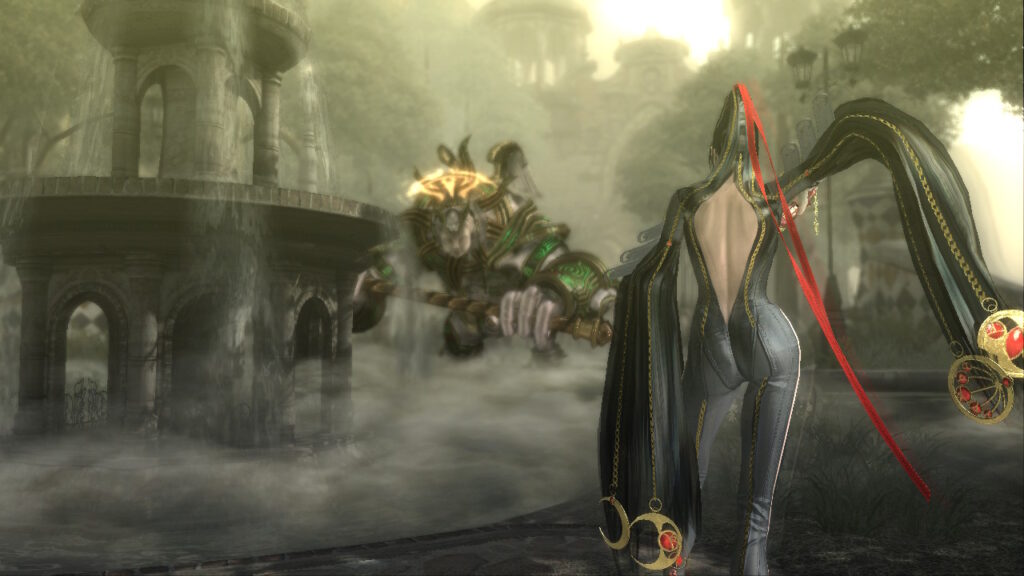
As if the exciting intro wasn’t enough, the prologue to the story takes things further by having an absurd comedic action sequence involving a bumbling off brand Joe Pesci, and a big brawl in a cemetery. Bayonetta is introduced as a vivacious and domineering diva with a penchant for angel hunting.
After a 500 year nap, Bayonetta awakens with a bad case of amnesia. Her greaseball handler tips her off about a sacred artifact that may be a key to discovering the truth behind her origins. What transpires is a quest of literal self-discovery, while also throwing down with Heaven’s finest.
Hideki Kamiya does not get enough credit for his storytelling style. For such a boisterous action game, the man put a lot of thought into how the theme of self is layered into some of the scenarios. Even the animal motifs that represent each character have defined meaning behind them.
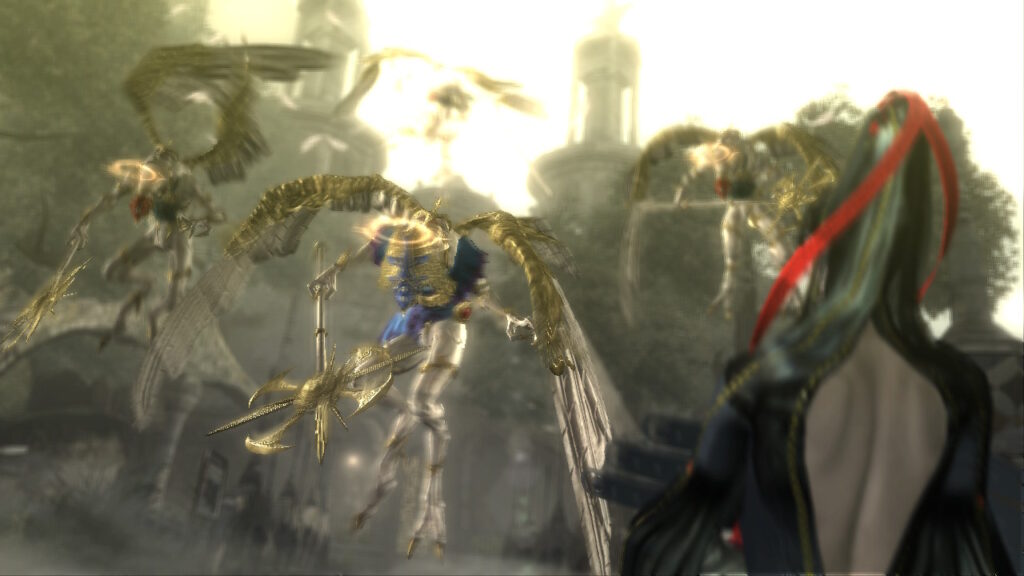
All the plot threads are more fleshed out than they initially appear, as supported by pages of flavor text that can be discovered throughout the game. Bayonetta also has the sense to not inundate players with clumsy exposition, and sets much of the lore aside to be read at the player’s leisure.
All of the background information and rules of the setting are all there to be read upon without getting in the way of the main story. What the Witch Hunts are and what they mean is not critical to connecting to the emotional core of Bayonetta’s abandonment. It is a very efficient means to expand the setting without breaking the bank.
Kamiya’s sense of humor is something that has also gone unappreciated in Bayonetta. Most scenes are punctuated with little sight gag, or will have characters make some amusing remarks. Other times, scenes will have outrageous choreography and comedic camera angles to emphasize on whatever makes Kamiya laugh.

Swooping cinematography that swings between legs and fills the screen full of of Bayonetta’s rear are played more for laughs than for eroticism. Her entire demeanor is so over the top and hyper-sexual that it stops being sexy, and just becomes funny.
There are tons of scenes that highlight the absurd sexuality and is perfectly illustrated in a scene where Bayonetta has what can be best described as a “pose competition” with a doppelganger. The irreverent tone and cheekiness of the entire experience is one of the reasons why cutscenes are so enjoyable in this action game.
Serious and dramatic dialogue scenes are kept to a minimum; appearing only where they would be most effective. These highly emotional moments are used effectively to make the player care more about the characters by adding a bit of depth. It would be impossible to connect with characters who were only defined by jokes.
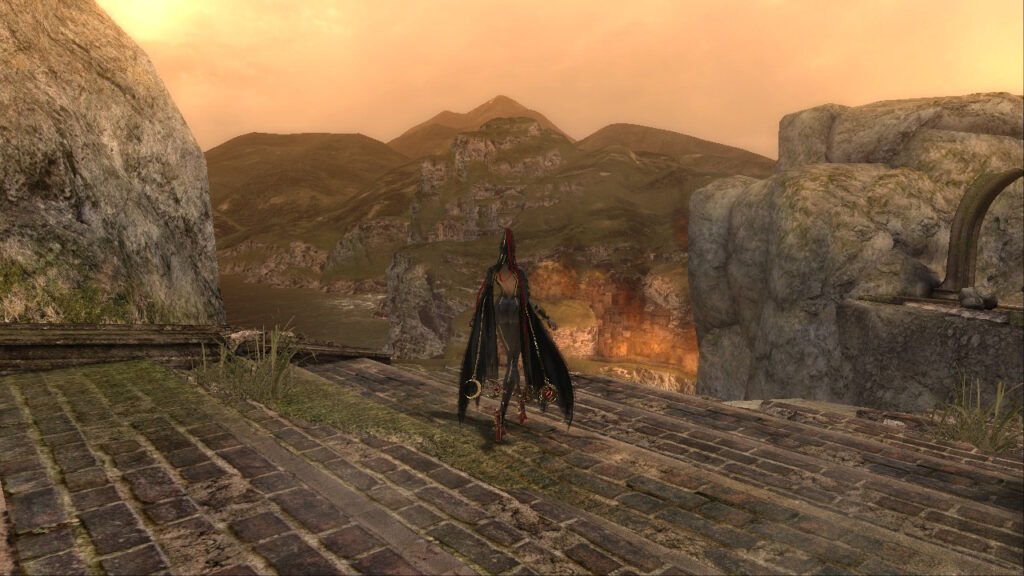
Having humorous cutscenes are brief reprieves from the long drought of action gameplay. It begs the question; why aren’t more action games leaning on comedy to drive a player forward? Gamers get a moment to come down from the high of battle, and comic relief sets in to begin the gradual build back to frantic fighting.
Sadly, not all cutscenes in Bayonetta are made equally. The reality is that this game was probably made on a limited budget, and Kamiya being the responsible game director that he is, prioritized assets be put into making the game play as best as possible. This meant that not all scenes would get the same attention as others.
Bayonetta makes extensive use of what can be best described as motionless character model slide shows. These cost cutting measures resemble something that would be shown to an animator for staging and camera blocking, almost like a crude animatic or 3D pre-viz storyboard.
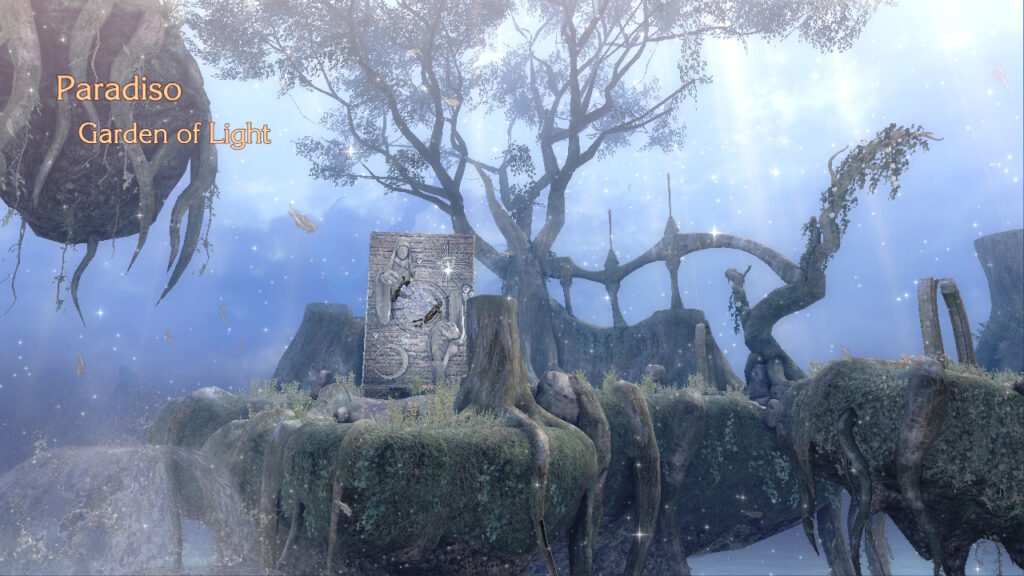
It is possible to adjust to the low budget cutscenes. The editing during these are fast and the framing is still stylish. These are directed well enough that you do manage to get the impression of some movement.
The upside is that when the high fidelity scenes do play out, PlatinumGames shows no restraint with the action. The outragoeus violence and over the top combat is reminiscent of the kind of action seen in 1980s anime, with huge attacks and bad guys getting their faces pulverized into pulpy mush.
The voice acting matches the quality of the production. Bayonetta looks exactly like how she sounds; a sophisticated and flirty lady with a pragmatic sense to combat. She isn’t above sucker punching her opponents and loves to boast. Despite what the fans say, she really is nothing like Dante from the Devil May Cry series.
Hellena Taylor truly embodies Bayonetta. She is one of those voices who can’t be replaced since so much of the character is defined by Taylor’s cadence and line delivery. The dialogue and trash talk Bayonetta says works so well because her actress is utterly committed to the role.
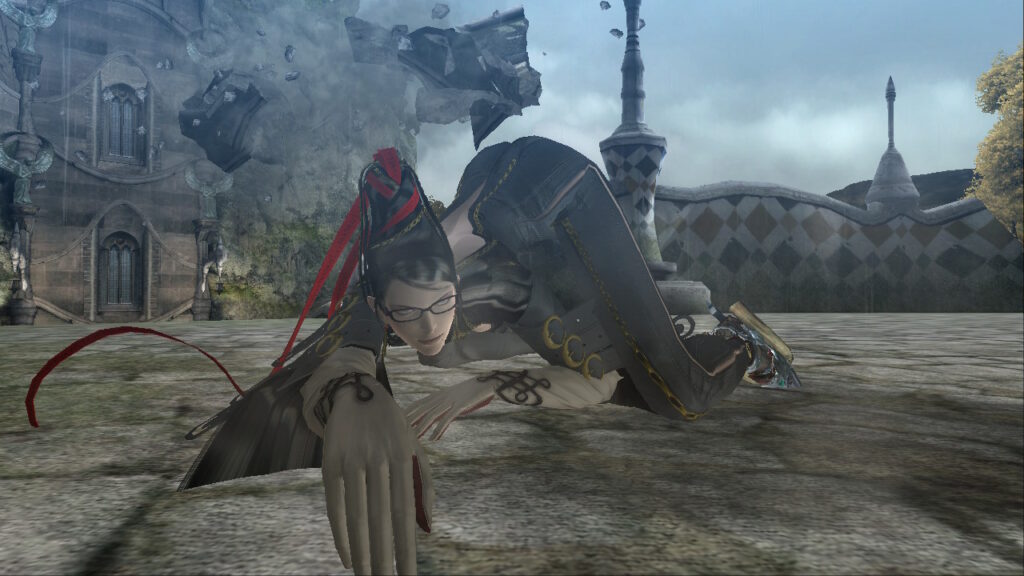
The visuals and art direction of Bayonetta were carefully considered. PlatinumGames opted for a stylized and exaggerated style that evokes the aesthetics of fashion production and gothic art. The graphics get the job done by today’s standards, but in 2009, this was considered one of the better looking Xbox 360 games with a high frame rate.
Vistas were expansive and atmospheric. Characters have elongated limbs which not only makes them look somewhat elegant, but also serves the gameplay since longer limbs work better for beat em’ up gameplay. Bayonetta has expansive and long reach with exaggerated poses and animations that emphasize her features like model on a catwalk.
Enemy designs are equally creative and weird. Some defy description while others have elements of baroque and rococo motifs. Extensive use of classic angelic imagery is juxtaposed with what can be best described as manga-esque body-horror. The effect is fantastic, and leaves a strong impression.
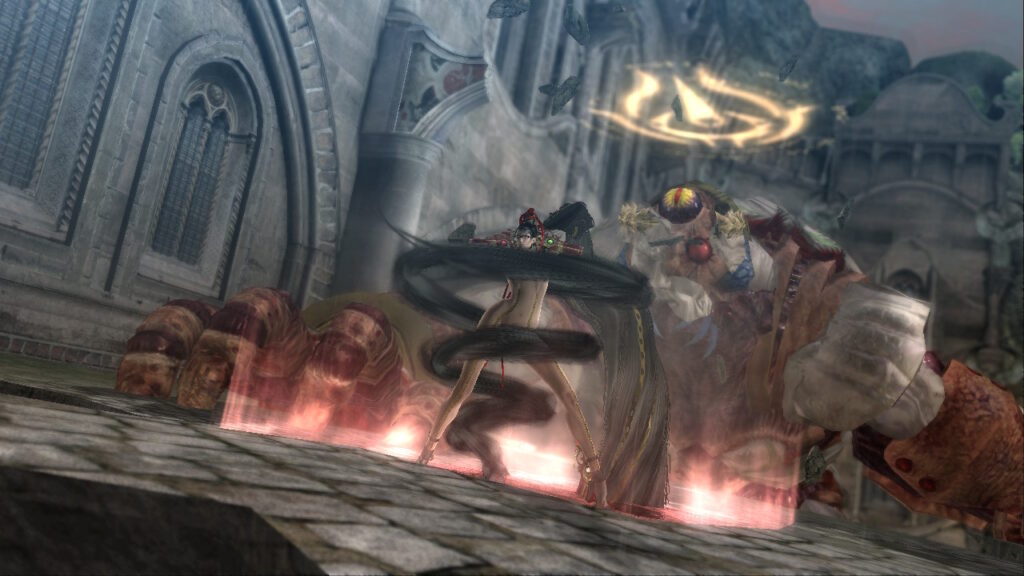
Thankfully, Bayonetta is just as much fun to watch as it is to play. For whatever reason, there are very few stylish action games made these days. Outside of Devil May Cry and other titles from PlatinumGames, the genre has been poorly represented since Bayonetta first came out.
Little did the world know, that this not only would be one of the last of its kind, but also be one of the best examples of its kind. Bayonetta is a fast game. Many newcomers might be shocked by how fast the action can get. Enemies can swarm the area and some a hulking monstrosities that fill the screen. Compounded with a huge move list, it can be overwhelming for some people.
Bayonetta controls very tightly. Her basic punches and kicks snap quickly, and can be drawn out as long range attacks since she has guns on all of her limbs. Since her combo list is very long and the game only relies on two buttons, it is very easy to pull off some intense moves.
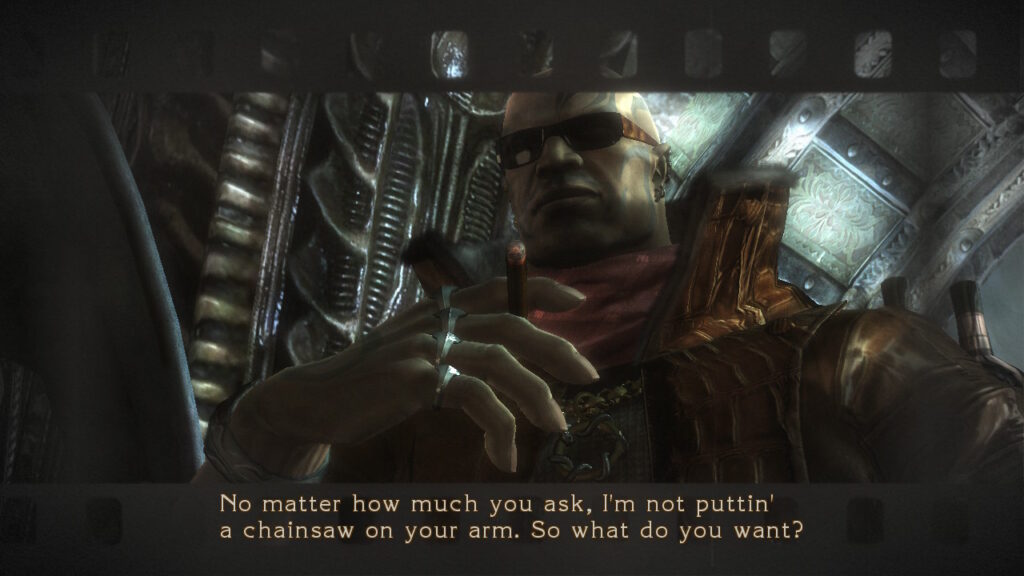
One stroke of genius is that some inputs make use of delayed presses, which is like Bayonetta performing a wind-up for a powerful attack. This makes the fighting mechanics feel very natural, and keeps the player focused on what they are pressing and when.
Compounded with a weapon swapping mechanics that allows switching weapons mid-combo, dodge off-set, and parrying; the potential for expression during battle is limitless. Bayonetta has a lot she can do, and it is up to the player how these powerful abilities will be used.
Almost nothing is off the table. Bayonetta can use enemy weapons against them, throw cars, and use her signature magical abilities. Torture attacks cost a great deal of magic, but also cause a huge amount of damage. They come with an amusing animation and can be a great way to get big numbers on your score when used at the right time.
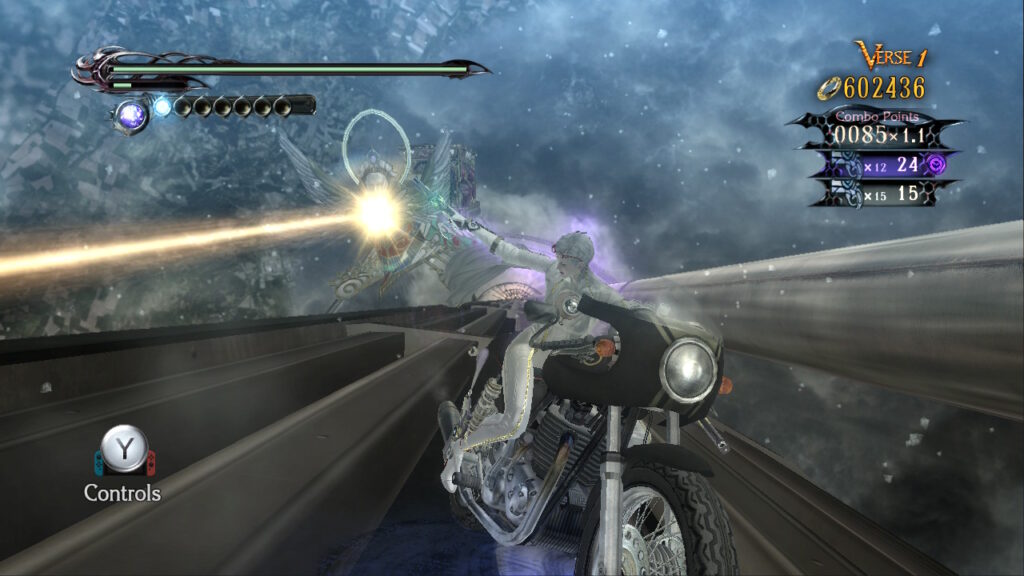
Less powerful magical attacks that use Bayonetta’s wicked weave are useful for broad and sweeping assaults on groups of angels. Other times they can be used to launch a choir boy up into the clouds for some easy air-juggling.
Packing in hundreds of moves into two buttons and mixing in simple analogue stick snapping gestures is one of Bayonetta‘s greatest design choices. Kamiya and his team came up with a genius input system that gives unmatched range of options when fighting, and it’s obvious why so many of the systems in Bayonetta found their way into future titles by PlatinumGames.
One of the greatest joys in stylish action games is making big numbers from high level play. It is how the tremendous quantities of halos are earned to buy more goodies from Rodin’s shop. Things like new weapons, costumes, upgrades, consumable items, and new abilities are available for a price… So long as Ms. B can make the grade.
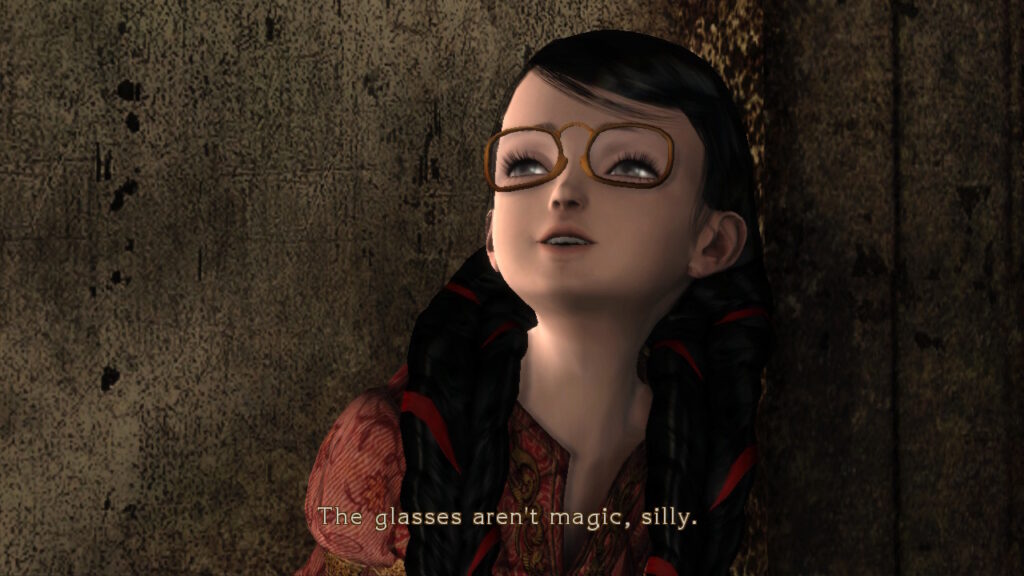
Bayonetta’s melee prowess won’t be enough to maintain a high combo. Powerful attacks will kill enemies too quickly, and don’t net a high enough multiplier.
This is where the seemingly weak guns come into play. Most players will scoff at their pathetic damage output, but an enterprising gamer will note how the Scarborough Fair increases the multiplier while hardly bruising low tier seraphs.
This is where a lot of Bayonetta‘s depth thrives. Trying to gauge how long to keep that combo rising with a weak ranged attack, and then going in with some devastating melee or wicked weaves. This is also while trying to avoid damage with witch time or parrying.

These actions contribute to Bayonetta’s multiplier, and if she is able to manage her self in a stylish and cool manner, she may net herself a handsome Pure Platinum rank for that verse (mission) and a hefty sum of halos. These encounters become very tense, since a combo can easily be broken by being too trigger happy with the dodging, or not paying attention to an enemy’s attack cue.
Threats are fairly generous with their attack telegraphing, since they have a distinctive audio cue that is easy to react to, and shimmer with a noticeable gleam as they strike. Bayonetta‘s combat system is also fair enough that angels will never attack from off screen, and will shuffle themselves into the player’s vision.
This feature is something that can be used to the player’s advantage since Fariness, Grace, and Glory tend to be some of the most aggressive and fast moving angels in the choir. The game never explains this mechanic, but it is there working in the background to keep the experience from becoming too difficult.
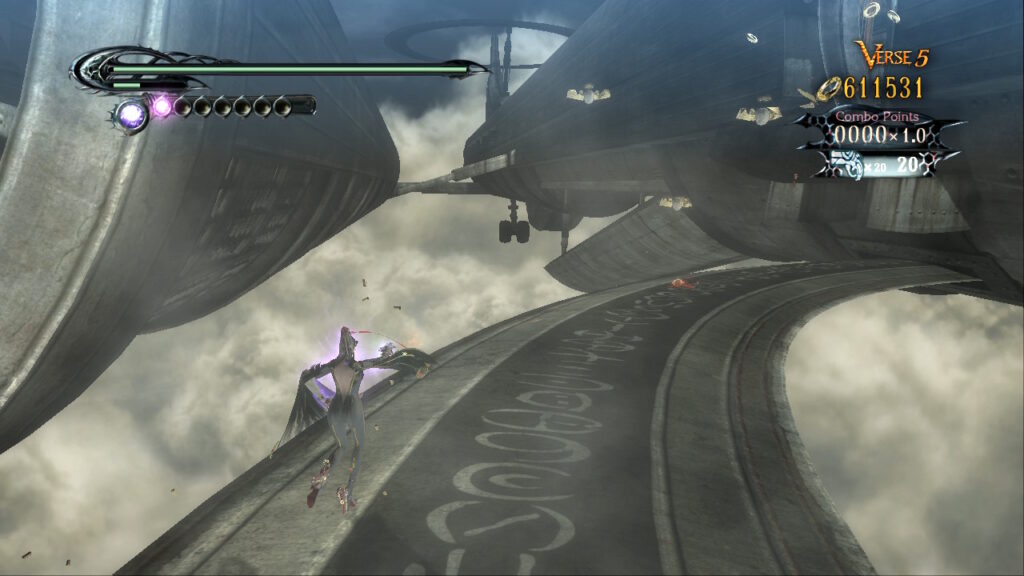
The only drawback to Rodin’s shop is his pricing on his inventory. The idea of locking advanced moves behind a shop like this is to keep the game simple enough for first timers. It serves almost like training wheels, and unlocking more moves is the game’s way of expanding the mechanics.
Frustratingly, basic functions like air-dodging come at a high cost, and to get all the important moves out of the way will set Bayonetta back by a big chunk of change. The halos she earned should be used for the substantial upgrades like the extra pair of shotguns, Sergey’s Lover, or the Infernal Communicator. Buying basic but necessary abilities feels like a waste of time.
Some abilities are too useful and are stuck behind fairly high price tags. Without grinding by replaying levels, it can take a while to earn some of the most useful abilities like parrying- which is tied to the Moon of Mahaa-Kalaa, or the Nintendo exclusive Hero of Hyrule costume.
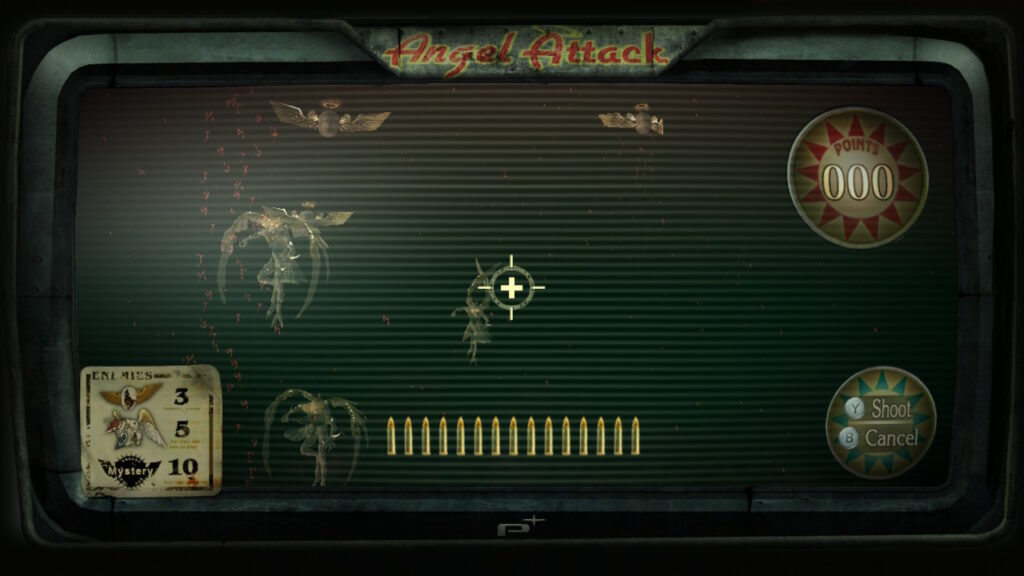
While playing Bayonetta on non-Nintendo platforms, players will miss out on the Nintendo themed costumes. While most of them have some minor gameplay tweaks done to them, it is the Hero of Hyrule outfit that stands out for having the Moon of Mahaal-Kalaa parrying function built in.
Link’s outfit is also ten times cheaper to acquire than the Moon of Mahaal-Kalaa, which means Nintendo gamers can free up an accessory slot. This makes for a very interesting gameplay difference, and allows some users to make Bayonetta more powerful than on any other platform.
It is too bad that parrying is tied to an accessory, and should have been a core ability like break dancing. It is an ability Bayonetta should never be without, and she is only able to carry three accessories. This usually results in players ignoring the more interesting or fun options like making doppelgangers or summoning small demons for bonus combo multipliers.

Bayonetta has been ported to many consoles, and is widely available. PlayStation 4 and Xbox One owners are in luck for having the option of the 10th Anniversary edition, which supports 4K image quality and runs at a perfect 60 frames per second. Buying the physical disc version runs very cheap, and also is bundled with the criminally underrated Vanquish.
The only downside to this version is that it does not come with the exclusive Nintendo content. Sadly the only physical version of Bayonetta for Nintendo Switch is a very rare special edition that was exclusive to Japan. The only other option for Switch owners is the digital eShop version, which runs the highest price at $29.99.
Fortunately, Bayonetta runs very smoothly on Switch. This was a very taxing game when it came out, and the original Xbox 360 version was only able to maintain a 60 frames per second via backwards compatibility on an Xbox One. Being able to take Bayonetta on the go is certainly an appealing factor, but it is the most expensive way to play it.
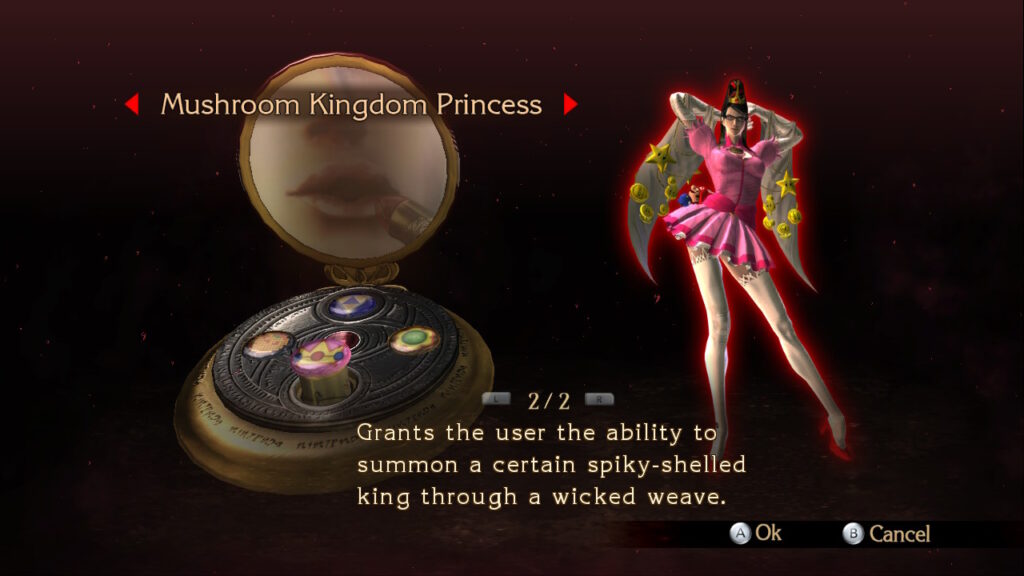
Bayonetta boasts an iconic soundtrack that mixes elements of jazzy pianos and angelic orchestra. Frank Sinatra’s Fly Me To The Moon is a constant motif through the entire experience, and carries a bit of a cheeky double meaning into the game’s plot.
There are multiple interpretations of the melody, some with a wild saxophone riff that plays up the smutty and sexy persona of the game’s heroine. Some of the more serious and ominous musical cues have airy and sweeping cues that have a sense of impending doom with a heavenly chorus.
The soundtrack is intensely defined, that it is impossible to imagine it any other way. It’s infectious and sets the mood perfectly, putting the player in the right state of mind to want to fight some angels in a cool and stylish way. Potentially spanking them.
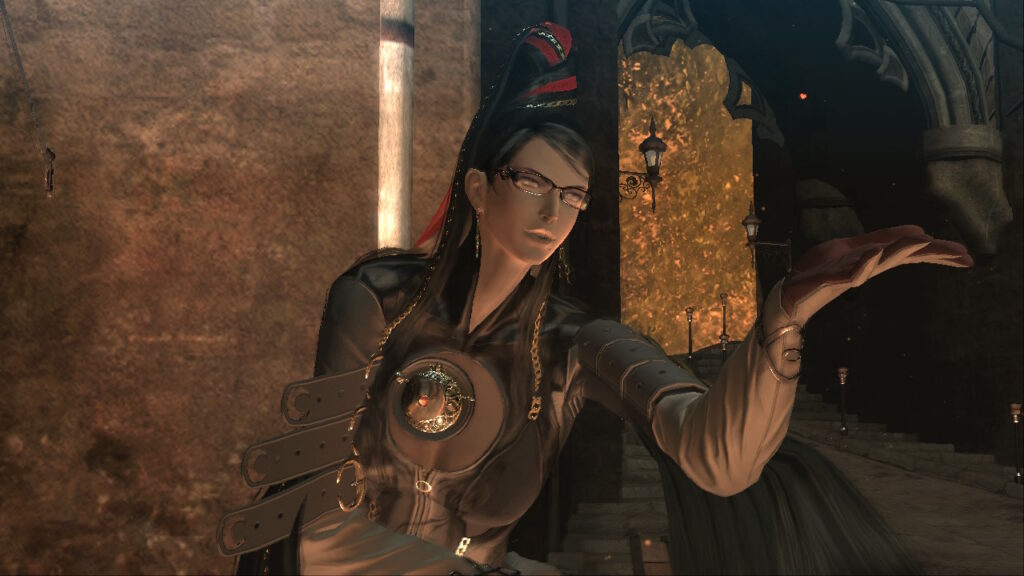
Bayonetta has aged gracefully. It is one of the best examples of the stylish-action game variety, and keeps players coming back for replays; thanks to addictive action and large quantities of unlockable content. It is lenient enough that anyone can pick it up and win by attrition, thanks to generous checkpoints but has a high enough skill ceiling for enthusiasts.
Some parts of Bayonetta aren’t perfect- like the instant-death quick-time-events or the motorcycle level dragging on for far too long. In a way these flaws add a bit of character to the experience, and make it more memorable. It is hard to find a fault with a game that recreates the arcade experience of Space Harrier for an entire level.
Bayonetta exudes confidence in its design. Hideki Kamiya and his team knew exactly what kind of game they wanted to make, and the quality shines brightly thanks to being responsible with their priorities. Bayonetta has kept gamers playing it for a decade, and they are likely to continue to keep playing it for more decades to come.
Bayonetta was reviewed on Nintendo Switch using a personal copy. You can find additional information about Niche Gamer’s review/ethics policy here.